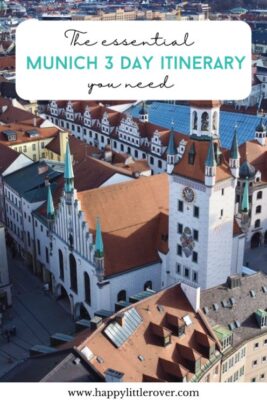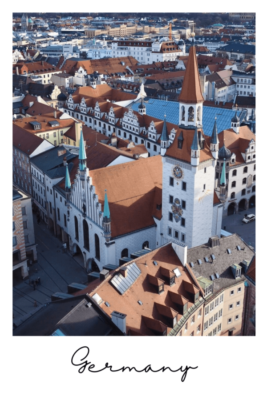The perfect Munich 3 day itinerary for visitors
Searching for the perfect Munich 3 day itinerary to take in all of those magnificent sights?
Wondering how to best plan out your days in the Bavarian capital amidst endless cathedrals and Baroque palaces?
I’ve broken down the massive list of what to see in this vibrant city into three delightful days.
Stick around to find out how to fill your 3 days in the third largest city in Germany!
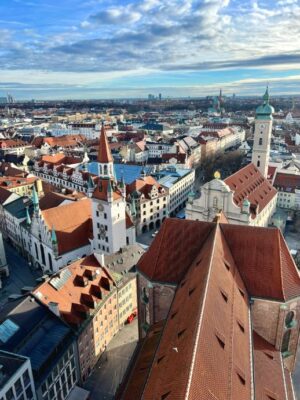
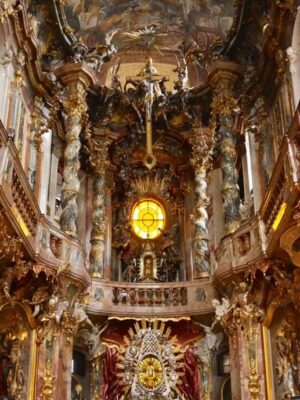

How do you get to Munich?
You can reach Munich by plane, train, bus or car, since it’s such a big city, it has excellent transport links with other European and German destinations.
By plane:
The jumbo sized Munich Franz Josef Strauss Airport (code: MUC) is a bit of a way outside the city centre but has public transportation links via local trains and busses.
A single fare from Munich airport into the city centre on the S Bahn will cost you 13€, a day ticket will only set you back an additional 1.80€ if you’re travelling further via trains. A ticket machine is located right next to the baggage collection area.
The Lufthansa Express Bus is 11.80€ for a one way trip and runs every 20 minutes. You can also catch a taxi or Uber into the city centre but this will be considerably more expensive, unless you’re in a large group.
By train:
Munich Central Station or Hauptbahnhof (abbreviated as HBf) as it’s known in German, is located just a short walk to the city center and has both domestic and international trains arriving (ah the glories of European travel).
Upon arriving into the large hall in Munich, head towards the east end of the station and follow everyone else.
Here you can swap onto any number of transport links to get you out in the suburbs or simply stroll to your accommodation to drop those bags off and get exploring!
There’s also a shopping centre attached to the main station but I can’t say that I’ve ever explored it!
I’d recommend heading out into the city to get something to eat but if you’re after a pretzel or a similar snack, there’s plenty of suitable venues to grab one here.
By bus:
The main bus station (Zentraler Omnibusbahnhof or ZOB in German) lies a bit further west of the main train station and is serviced by providers such as Flixbus and other regional providers.
There are some food spots and a Lidl supermarket but you will probably have more luck stopping into the train station if you’re looking for a snack on your way to an early morning bus. You can jump onto a tram from here into the city centre, there’s a stop close by, or wander your way in.
It’s only slightly further out compared to the train station. The bus station is unfortunately a bit grimier than the train station but don’t be put off! This is a common sight in many European cities and I don’t know about you but the bus stations in Australia can also be quite rundown. Munich has much more to offer than the bus station.
Let’s assume that you’ve reached Munich, dropped your bags off at your accommodation (don’t forget your padlock for your bag zips) and you’re raring to get going and explore Munich!
Fancy a full self-guided walking tour of Munich instead? Walk this way!
Munich 3 Day Itinerary - Day 1 Overview:
Here’s your overview of your sights for the first day, continue on for more detail on each stop!
1. Stacchus/Karlsplatz
2. Bürgersaalkirche
3. St. Michael München
4. Asamkirche
5. Sendlinger Tor
6. Hackerhaus
7. Münchner Stadtmuseum
8. Rindermarkt + Ruffinihaus
9. Alter Peter (St Peter’s Church)
10. Viktualienmarkt
From buzzing Stachus to the lavish Asamkirche
First up, you’ll come to the bustling square of Stachus and the first city gate of Karlstor, the water fountain out in the middle is surrounded by an ice-skating rink in winter.
Dubbed Stachus by the locals to avoid its official name of Karlsplatz, after WWII it was said to have been the busiest intersection in Europe!
The salmon pink façade of the Bürgersaalkirche stands out in the shopping precinct of Neuhauserstraβe, ascend to the magnificent upper hall to take in glorious frescoes and gold accented details.
Entry is free to this former citizen’s hall, now stately church. Once you’ve explored here, keep walking into Munich’s Old Town, there’s plenty more to see!
Next, the enormous Michaelskirche, you’ll know it by the grand entrance dotted with white statues in their maroon niches and preserved statue of Archangel Michael dispatching a devil out front.
So large that it’s only outdone for size by St Peter’s Basilica in Rome, it also holds the royal crypt of the Wittelsbach family, including “mad” King Ludwig II.
Entry to the crypt costs 3€ but double check for service times first!
Opulent and decadent Asamkirche awaits you next, nestled in a shopping strip of all places and it has by far and away the most lavish chapel interior I’ve ever laid eyes on.
An absolute must see when you’re in Munich and I promise your camera will adore every inch of this tiny chapel.
Built by two brothers keen to make a name for themselves, they were the toast of Europe once the doors opened on the golden splendour inside.
Don’t miss the statue of Death by the door with a golden thread symbolising life held precariously between golden shears, another fascinating detail of the space already overflowing with symbolism.
The Sendlinger Tor, framed by two staunch red-brick towers on either side and draped in greenery, dates from 1318.
Once surrounded by a moat and accompanied by a drawbridge, these days it’s a reminder of Munich’s power over the centuries.
You can only imagine what it must have been like for simple village folk to enter through these imposing gates back in the Middle Ages, they’re still impressive now in the 21st century.

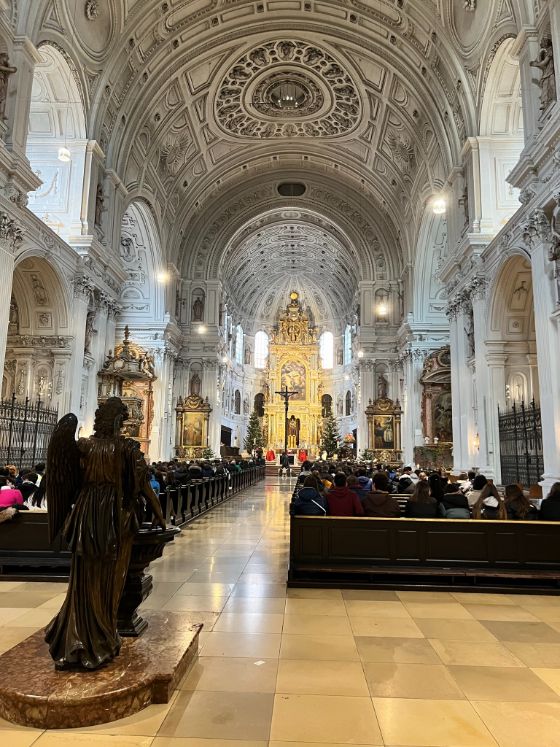
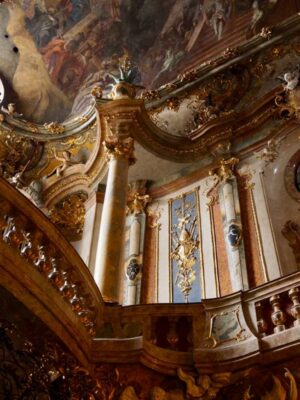
Traditional breweries and historic belltowers
Time for a stop for lunch to rest and recharge before an afternoon of sightseeing, head over to Hackerhaus for a delicious, hearty look at Bavarian classics.
The historic pub serves up beer varieties from Hacker-Pschorr, one of Munich’s most famous brewing families.
They also run a celebrated Oktoberfest tent so if you’re not here in time for the biggest beer festival in the world, this is the perfect spot to stop by and sample some of their brews.
Nothing like settling into a cosy booth with a stein of beer and fresh Obatzda, a mix of fresh cheese, spices and a splash of beer, best served with crispy Brezen!
After lunch, a gentle stroll will find you at the interesting Münchner Stadtmuseum, covering the history of the city from its beginnings as a monastery through to the modern era.
The building it occupies is a former armoury with its green copper turrets on each corner.
Entry is 7€ and includes an audioguide in English, most signage is in German though so keep that in mind.
You’ll also find the modern Jüdisches Museum München nearby, if you would like to learn more about the history of the Jewish community in Munich.
Our next stop within walking distance is the irregularly shaped Rindermarkt square, which used to house the cattle markets of Munich, you’ll find the large fountain surrounded by sculptures paying homage to their bovine roots.
The Ruffini House, covered in decorative frescoes, is a grand reconstruction of a rich merchant’s home which used to stand on the square. It’s also a pleasant spot to sit and catch your breath for a moment, or go say hi to the cows.
Alter Peterskirche, or Old St. Peter’s, is just around the corner and marks the original site of the Benedictine monastery that gave Munich its name, it’s also the oldest church in Munich.
The church you see today dates from 1327 and you can’t miss the breathtaking view from climbing the bell tower over the town hall, Frauenkirche and Marienplatz of the old town (entry cost is 5€ for the tower). You might even be able to spot the Bavarian Alps on a clear day.
While you’re inside the cathedral itself, don’t miss the gilded altar and jewel studded skeletal remains of St. Munditia, one of the stranger sights you might see in Munich.
After marvelling at the ancient majesty of Alter Peter and getting your breath back after the 308 steps to the top, the Viktualienmarkt is your final bustling stop for the day.
Over 100 fresh produce stalls, a shaded beer garden and multiple restaurants await your patronage, as they’ve done for centuries in this same square.
Whether you’ve got your eye on a piping hot bratwurst or coffee and cake at the Lea Zapf Marktpatisserie, there’s something here for everyone and is highly worth visiting for a bite to eat.
Don’t miss the maypole located right at the centre of the market, decorated in blue and white – the Oktoberfest colours.
Looking for the detailed guide to Oktoberfest Munich AKA the biggest beer festival in the world?
Munich 3 Day Itinerary - Day 2 overview:
1. Frauenkirche
2. Marienplatz
3. Neues Rathaus
4, Altes Rathaus
5. Hofbräuhaus
6. Alter Hof
7. Munich Residenz
8. Feldherrnhalle
9. Theatinerkirche
10. Englischer Garten
Jumbo sized cathedrals and fairytale town halls
Welcome to the second day of your Munich 3 day itinerary in the Bavarian capital, we’re starting off our full day with a bang.
You admired the view of this, frankly enormous, cathedral with its twin onion domes yesterday, the Frauenkirche is first up.
Constructed mostly in the 14th century, the cathedral holds up to 20,000 people at a time, more than the population of Munich when it was built strangely enough.
Restored after damage in World War II, don’t miss the legendary “Devil’s Footprint” as you wander through the sturdy columns, you’ll spy the bronzed plate with said footprint in the centre of the space.
Wander to the magnificent Marienplatz, named for the Marian column (Mariensäule) topped with a golden figure of the Lady Mary in the centre of the square.
Dominated by quintessential sights such as the Neues Rathaus with its Glockenspiel and the Altes Rathaus at the far end, this is the beating heart of Munich with its historic buildings.
The many spired, fairytale Neues Rathaus (New Town Hall) hosts the most famous show in Munich – the glockenspiel high on the clock tower starts up twice a day (11am, 12pm), both knights and dancers emerge, twirling and jousting. And bringing the bustling square below to a standstill.
They tell the story of the history of Munich and the figures are all life-size, though they don’t look it from the ground.
Don’t miss the Wurmeck on the west end of the building, where a dragon scales the building as a homage to the plagues that ravaged the city in the Middle Ages.
If the steps over at Alter Peter aren’t really your style, the Neues Rathaus also has its own observation deck which can be accessed via an elevator.
You can enjoy the stunning view out over the city, across the square to Old Peter and off to the Alps if the weather behaves! Adult tickets will set you back 6.50E and there are even extended opening hours when the Christmas markets are on, so you can enjoy the view until 9pm.
The Altes Rathaus (Old Town Hall) lies at the far end of Marienplatz with its merry red roof and copper spires, adjoined by the Talburgtor watchtower.
It was faithfully restored after being totally destroyed in WWII bombings to its original position, spy some original statues high on the watchtower as you pass.
What we see today is only a portion of the structure that used to stand here, things were also adjusted as Munich’s population grew and they needed more space!


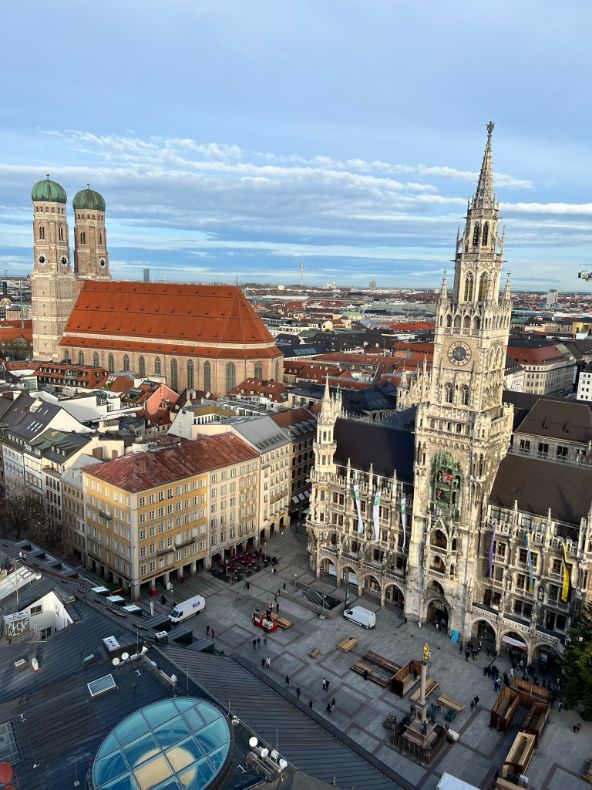
Beer halls and other royal haunts
For lunch, I’m taking you to the most famous of Munich’s culinary institutions, the state-owned Hofbräuhaus beer hall.
Built in response to the poor quality of Bavarian beer in 1589 (I’m sure this fact makes Bavarians shudder in their boots) for royal consumption only, luckily, it’s been opened up for us common folk in the interceding centuries.
Infectiously rowdy inside, with live oompah music and serving staff in traditional dress, this is the next best thing to a taste of Oktoberfest.
Order a pork knuckle, a Maβ of beer and take in the atmosphere, the perfect place to enjoy Bavarian hospitality.
Over to the Alter Hof, this ancient palace was the first home of the Wittelsbach dynasty which reigned for more than 700 years.
Somewhat restored after destruction in WWII, the large courtyard used to be full of farm animals and small gardens, while the buildings housed government offices after the royals decamped to other estates.
We’re off next to the Wittlelsbach’s next palace, the Munich Residenz, a much grander neighbour.
Baroque splendour reigns across the stately rooms and gilded theatres, head to the glistening Antiquarium for an idea of the sheer wealth of Bavaria’s former royal family.
The treasury is filled to the brim with priceless jewellery and gems collected by kings over the centuries, the combo ticket for both the museum and treasury is 14€.
Give it at least 2 hours to admire the gloriously rebuilt surroundings and don’t forget to grab your free audio guide, you can book ahead for a guided tour if you’d prefer.
After being dazzled by the glamour of the Residenz, step out to the Odeonsplatz and our next two sights, practically neighbouring each other.
The grand Feldherrnhalle, modelled on the Loggia dei Lanzi in Florence, is dotted with statues of Bavarian military heroes and has seen its fair share of historical moments, including declarations of war.
The majestic lions flanking the stairs are a popular photo op and a great place to admire the beauty of the square.
Just over the square is the daffodil yellow Theatine Church, built to commemorate the miracle birth of Prince Max Emanuel, the light, airy interior is filled to the brim with cherubic angels, vines and flowers.
In direct contrast to the yellow outer, inside almost every feature is pure white, take your time marvelling at the intricate details.
Make sure to pause for as much time as you need in this serene space, on a sunny day, the beams of light streaming in through the windows are a sight to behold.
Your final stop is the city’s playground, the sprawling Englischer Garten (English Garden), the largest metropolitan park in Europe and larger than Central Park in New York.
Stop by the Eisbachwelle to see intrepid surfers taking on the waves of the Eisbach River (helped by a pumping system churning the river up).
If you’re hungry, stop by the charming Fräulein Grüneis for coffee and cake or while admiring the heritage Chinesischer Turm, stop into the famous beer garden here.
Don’t miss the quaint hill-top Monopteros Temple on the way. Enjoy your relaxing afternoon in the beautiful gardens and I’ll see you tomorrow for day 3!

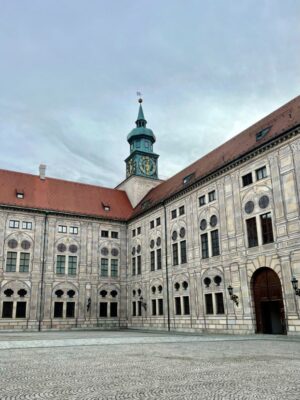
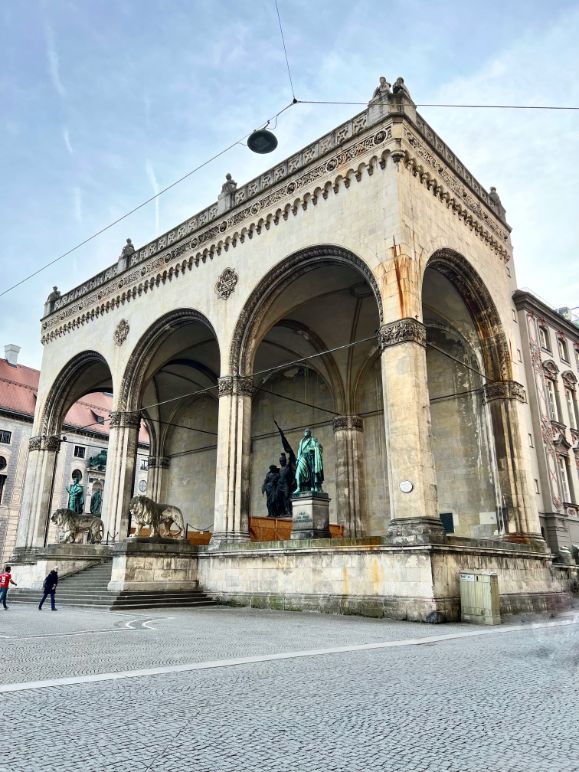
Munich 3 Day Itinerary - Day 3 overview:
1. Schwanthalerhöhe for brunch
2. Theresienwiese
3. Schlosspark Nymphenburg
Or
1. Schwanthalerhöhe for brunch
2. Alte Pinakothek and/or Pinakothek der Moderne
3. Souvenir shopping at Max Krug
Or
Organise a day trip headed out of the city, options include:
1. Neuschwanstein Castle
2. Nuremberg
3. Salzburg
Choose your own adventure: summer palace or art galleries galore
Today you have your own decision to make about what you feel like seeing.
If the weather isn’t so great, the Alte and Neue Pinakotheks might be calling your name with oodles of art to go admire.
If the weather’s good, I would highly recommend heading out to see the idyllic summer palace of the Wittelsbach royals.
But first, if you have time to spare, breakfast over in the trendy Schwanthalerhöhe district, a tad southwest of the main train station. Or brunch if you feel like it, you’ve earned a sleep in after the sightseeing of the last two days.
Note: If it’s winter time when you visit, the Nymphenburg palace can still be enjoyed but you’ll miss out on the darling Amalienburg and the other luxurious garden pavilions as they close in the off season. Personally, I would save Nymphenburg for a time when you will be able to maximise your time and see all the buildings.
If you’d prefer to spend the final day heading out on a delightful day trip to Austria to see Salzburg (only 1.5 hours on the train) or setting out on an expedition to be amazed by Neuschwanstein Castle, I’ve got a whole guide to the best day trips from Munich all written up for you!
I’d skip brunch and grab something from the bakery at the station as you’re leaving!
Double check my guide over here for the best day trips from Munich for more info
Brunching with the cool kids
Formerly referred to as a neighbourhood of thieves, gentrification has made the area of Schwanthalerhöhe a bit of a hotspot, you’ll find quirky cafes serving up smashed avocado and oat milk lattes galore.
Try Notting Hill Café with their extensive menu of breakfast classics or Bean Batter for delicious waffles. And it goes without saying, good coffee to start your day right.
Once you’re done with breakfast, Schwanthalerhöhe adjoins the home of Oktoberfest, the Theresienweise.
This enormous meadow doesn’t look like much outside of the festival season but for two weeks from mid September through to early October, it’s transformed into an enormous beer guzzling party.
And with ferris wheels and carnival rides amongst the gigantic beer tents.
After seeing the home of Oktoberfest, you can easily catch public transport out to the palace, S-Bahn or tram line 17 towards Amalienburgstraße will take you straight there from in front of the main train station.
Looking for another brunching hot spot? How about my Berlin 3 day itinerary?
A summer palace fit for a king
Originally a small summer palace, Nymphenburg was refurbished over the centuries to become the sprawling estate and summer escape out to the country for the Wittelsbach Royal Family, even if it’s now part of greater Munich.
Lavishly decorated inside in the Baroque and Roccoco styles, you can admire the main palace, the prettiest carriages you ever did see at the Marstallmuseum and there’s even a porcelain factory still producing dishes fit for royalty.
Outside in the sprawling palace grounds, you’ll find a huge bathing pavilion (Badenburg), oriental styled pagoda (Pagodenburg) and the stunning Amalienburg, considered the jewel of the palace.
Entry is 15€ in the summer for the full combo ticket, its only 8€ to just enter the palace itself.
Double check their official website for any closures for restoration works before you go!
Give yourself around 4 hours out here to stroll around the palace and glorious gardens, bonus points if you pack a picnic to enjoy on a shady bench out in the palace grounds.
Centuries of art waiting just for you
If you’re visiting in winter, instead of seeing Nymphenburg, try checking out the Alte Pinakothek gallery for classical works of art or the Pinakothek der Moderne for more modern collections.
The Alte Pinakothek refers to the age of the works of art held within, from the 1300s through to the 1700s and holds works by Leonardo da Vinci, Raphael, van Eyck and Botticelli, among many others.
Admission is 7€ for adults and only 1€ on Sundays, I find myself wishing that I was in Munich on a Sunday! Children can go for free.
If you’re planning on also visiting the modern art Pinakothek, the day pass will allow entry into both museums for 12€, saving you 5€.
If you’re feeling more modern and not in the mood for the medieval masters, the Pinakothek der Moderne is just over the road, housing four separate museums within the colossal space.
The four collections cover 20th and 21st century art across paintings, sculpture, architecture and graphic design. You’ll need a few hours here to appreciate some of the 250,000 works held within the museum.
The famous sister museum, the Neue Pinakothek, is currently closed for substantial renovations and is due to reopen in 2029.
Some of its more famous works can be seen in a special exhibition in the Alte Pinakothek until the end of 2024.
If you still have time and you’d like to browse for souvenirs, or just be wowed by an enormous variety of cuckoo clocks, your final stop should be the Max Krug souvenir shop back near the Frauenkirche. Housing an incredible range of souvenirs and ornaments, there’s bound to be something here worth squeezing into your suitcase or shipping home.
After you’ve wandered through some very fancy bedrooms or admired all things art in Munich, knock off the last of the souvenir shopping or head straight to the nearest beer hall to enjoy one last Weizen before you go!
Feeling all that travelling in your back pocket? Try my Berlin budget travel tips out!
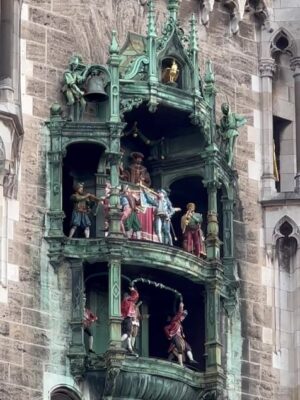
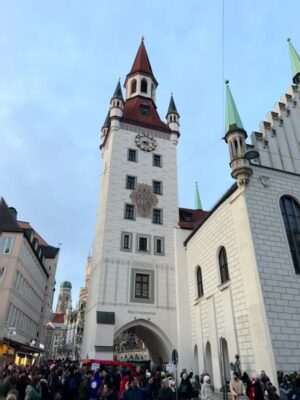

Your magical 3 days in Munich are all done!
That brings your wonderful three days in Munich to a close, we‘ve discovered some magical cathedrals, climbed bells towers and enjoyed Bavarian beer halls.
I hope that you’ve found this jam packed itinerary informative and it helps to guide you on the perfect trip to Bavaria’s capital when you go.
Plus I’m sure you’ll find your own hidden gems and favourite spots along the way, don’t forget to pin this post so you can find it later for your trip planning.
Where to journey to next, maybe sunny Freiburg in the Black Forest is calling your name?

